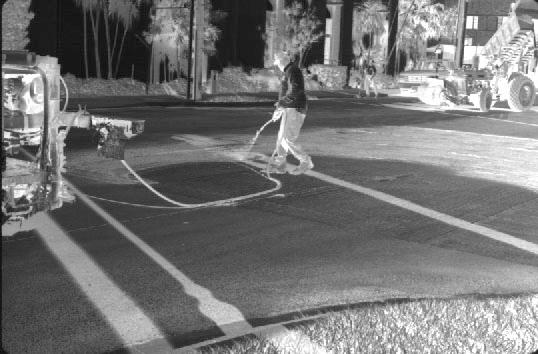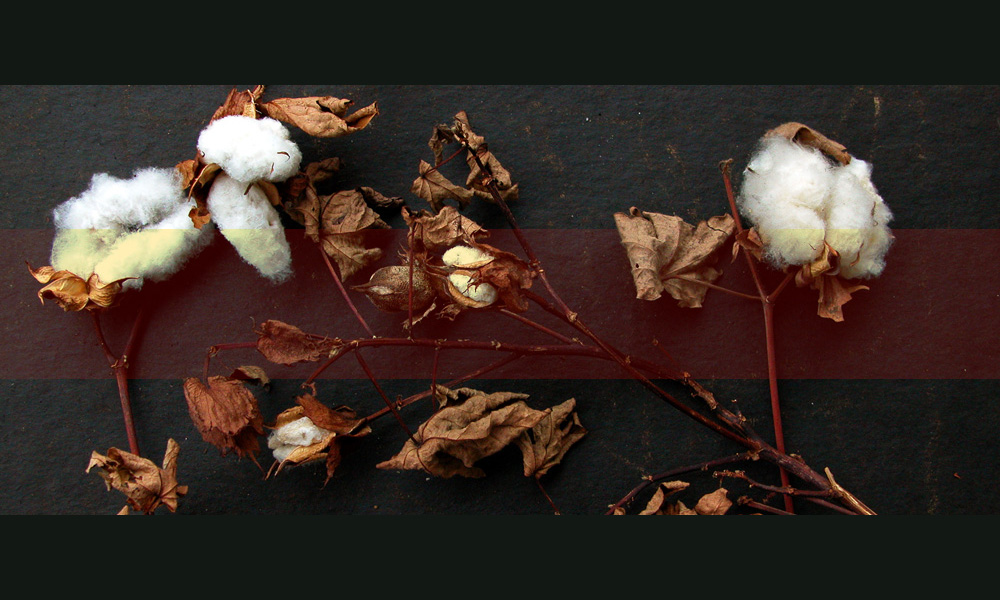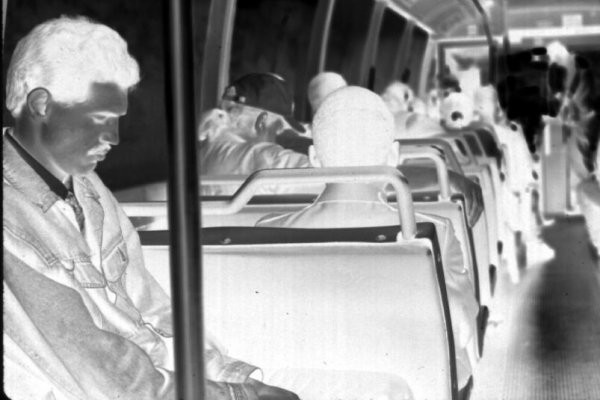Conversations: MDCC InterAmerican Art Gallery
This is an interview with Onajide Shabaka for his exhibit, “Cotton and Iron,” at the InterAmerican Center opening September 18 thru November 8, 1996. Amy Capplezzo, Former Director of Galleries for Miami-Dade Community College, Miami, FL.
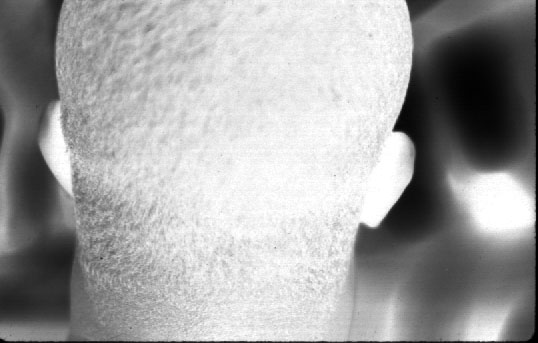
“Untitled (head)”
duratrans
30 x 40 in.
Amy: So Jide, I have so much to ask you about your work. There are a couple of things in particular I want to ask you about. The show is called Cotton and Iron and, clearly cotton and iron have some reference to labor, manual labor, physical labor, the kind of sweat equity sort of labor. Why did you choose that title for the show?
Jide: I think it fits not only with what you just said, but also historically, personally and politically. I had an installation piece back at the South Florida Art Center’s Ground Level space that dealt more with the whole migratory exodus of African Americans from the agricultural South into the industrial North. That is one thing you see here in the exhibition. The industrial kinds of things happening with these people; construction workers working in the streets after having moved to an industrial based economy.
Amy: … as opposed to the African roots being from the South and what it meant being from that kind of agricultural labor based society.
Jide: Right. That kind of agricultural labor was about life picking cotton like my grandparents and even my father as a young boy. Then, to moving north for factory jobs in cities along the Mississippi, Ohio, and Pittsburgh rivers.
Amy: That’s interesting. You have a lot of examples where I see that people are sweeping streets, shoveling pavement, laying concrete, whatever it might be. I guess in a some way I expected to see a train somewhere in your work. There’s so much about going from the South to the North that’s as about the train.
Jide: Well, I know there’s a whole relationship to metal there that I think is there. (There’re also references to Ogun, Yoruba orisha of metals.)
Amy: But it seems that men working in streets is some contemporary equivalent. Tell me a little about why you chose to focus on labor for this body of work.
Jide: Well, my work in the past couple of years has become a little bit more autobiographical. Although this work isn’t necessarily an autobiography, I have worked in construction and been close to the people doing this kind of work. Even though, I can’t say that’s my chose of a life occupation, there are some very interesting people that work in that area. The average person looking at people who work in that industry look down on them because they’re very simple people; people that use their hands instead of their intellectuality.
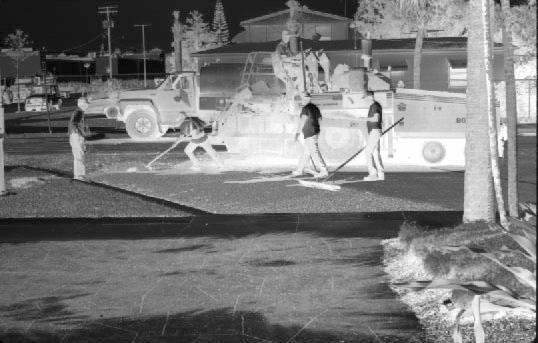
Amy: So you think this work is in some way homage to the working man.
Jide: Yes, to a certain extent.
Amy: Your drawings are stunning, by the way. They’re beautiful. This particular drawing on a piece of metal, I think it’s probably drawn with oil stick?
Jide: Um….that’s acrylic paint.
Amy: Acrylic paint? That very much looks like a drawing and I would never call this a painting. It’s sort of a drawing that uses paints. It’s a picture of a man whose eyes are kind of closed or absorbed and he’s wearing a gag in his mouth. It’s not exactly that he’s been blind folded, but instead he’s been silenced.
Jide: Right. That particular one does not have eyes drawn in. This image was dealing with the idea of people not having a voice, of people being prevented from seeing. Certain things are never seen and speech is muffled. So, they never have the opportunity to see things and, words are never heard or understood. So it’s like a metaphoric type picture. Still, a lot of the people I’m talking about can speak only through physical force. Many people I know in construction don’t know how to control their emotions, though not all of them. You know they get to a certain point and they just like go wild and challenge each other physically. When a serious confrontation comes up
it’s real physical. You can’t sit down at a table and discuss something.
Amy: Tell me about this piece “UNTITLED (2 cages)”, the pieces that are caged. One cage of beer bottles and the other cage is of uniforms and clothing.
Jide: I am focusing on a lot of traps and, cages are like traps. Whether we find ourselves inside of a trap or being baited and then going inside of it, that whole idea of containment and control is part of this show as well. When you see or think of people when they’re drunk and high you know they’re out of control. So to put the analogy to the caged bottles and clothing, it also a situation that was out of control until they were placed in the cages. This is a case of where control is forced from the outside the bottles themselves. If there were no cage, they would be sprawled all over the floor. And the clothes as well…
Amy: So this is like containment of a habit maybe?
Jide: Well, I don’t know if I would have thought of it in that sense, but it just seemed that the work clothes and the bottles fit together. People that work in construction and this kind of job tend to drink a lot. I mean I worked with people that used to drink on the first break of the day, 10am, every day. They’re hitting the beer bottles first thing in the morning, which I could never do. So, it just seemed to fit.
Amy: These are almost like demographic bits of information. For example, if you are a blue collared construction worker, laborer therefore you drink beer. It seems to have some sort of a cause and effect. You have a series of five
mounted black and white photographs that are negative image prints. They’re beautiful and beautifully printed. In three of those photographs, we see what looks like men laying pavements. In the final image, we have a figure of a person with his head down on a crowded bus.
“Public Transporation”
gelatin silver print
30 x 40 in.
© 1996
Jide: They were working right in the street and all I had to do was walk out the front door because it was at my job working for the Museum of Contemporary Art, Miami, FL. The images where the group with the asphalt paving machine was perfect. They were all in movement and that it happened really well. The image of the single guy with the shovel was in Atlanta just before the Olympics. They were still working on the streets up there but just the way he was moving was so dance oriented. It was like a ballet of him shoveling this asphalt off the street. It was really beautiful to watch him work.
Amy: So, it was like a choreography of labor basically.
Jide: Exactly. It was really beautiful and I’m also saying the same thing about the piece with the asphalt paving machine. It’s almost like a theatre piece where everybody’s in a certain place and everyone’s lined up. You have to work together to make that happen anyway. It’s not like one person can do that job alone.
Amy: Right. It is a little bit like a dance troop that has to work in harmony. There’s something about your work, particularly all the images of workers that appeal to me, in part because you basically aesthetisize this experience of labor which is an experience that is not normally thought to be very aesthetic whatsoever. I mean you’ve given it it’s own kind of aesthetic. In the caged pieces you’ve elevated the vices of the working man. In a more action oriented piece you’ve talked about how shoveling pavement can actually be elegant; a bit like ballet.
Jide: …. although, the average person may not see it that way initially.
Amy: Right. That’s kind of what art is about, it’s being able to aesthetisize common things. You change their meaning.
